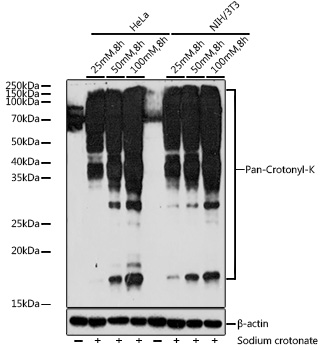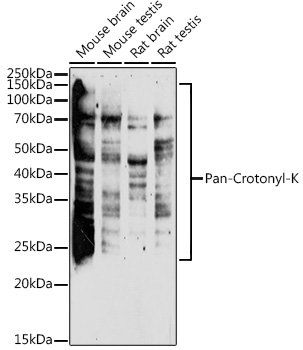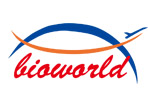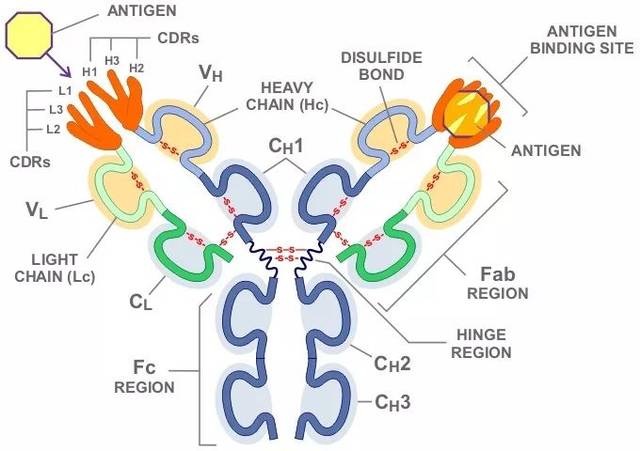Product Name :
Pan-Crotonyl-K polyclonal antibody Background :
Lysine crotonylation (Kcr) was first discovered about 10 years ago, as a PTM of histone. It was revealed that Kcr is an evolutionarily conserved and common PTM that occurs in both core histone and some non-histone proteins in a variety of organisms. Similar to other types of PTM, Kcr is a reversible modification. The classic histone acetyltransferases (HATs), p300/CBP, PCAF, and MOF, are responsible for most crotonylation events, while the histone deacetylases (HDACs) HDAC1/2/3 and SIRT1/2/3 reverse these reactions . The chromodomain protein CDYL acts as a crotonyl-CoA hydratase to negatively regulate histone Kcr by reducing substrate supply. CDYL-regulated Kcr of RPA1 plays an important role in homologous recombination (HR)-mediated DNA repair (23), while HDAC-regulated histone crotonylation is reduced after DNA damage . Product :
1mg/ml in PBS with 0.02% sodium azide, 50% glycerol, pH7.2 Storage&Stability :
Store at 4°C short term. Aliquot and store at -20°C long term. Avoid freeze-thaw cycles. Specificity :
Other Modified Immunogen :
A synthetic peptide corresponding to a sequence containing acetylatedK. Conjugate :
Unconjugated Modification :
Other Modified
Pan-Crotonyl-K polyclonal antibody Background :
Lysine crotonylation (Kcr) was first discovered about 10 years ago, as a PTM of histone. It was revealed that Kcr is an evolutionarily conserved and common PTM that occurs in both core histone and some non-histone proteins in a variety of organisms. Similar to other types of PTM, Kcr is a reversible modification. The classic histone acetyltransferases (HATs), p300/CBP, PCAF, and MOF, are responsible for most crotonylation events, while the histone deacetylases (HDACs) HDAC1/2/3 and SIRT1/2/3 reverse these reactions . The chromodomain protein CDYL acts as a crotonyl-CoA hydratase to negatively regulate histone Kcr by reducing substrate supply. CDYL-regulated Kcr of RPA1 plays an important role in homologous recombination (HR)-mediated DNA repair (23), while HDAC-regulated histone crotonylation is reduced after DNA damage . Product :
1mg/ml in PBS with 0.02% sodium azide, 50% glycerol, pH7.2 Storage&Stability :
Store at 4°C short term. Aliquot and store at -20°C long term. Avoid freeze-thaw cycles. Specificity :
Other Modified Immunogen :
A synthetic peptide corresponding to a sequence containing acetylatedK. Conjugate :
Unconjugated Modification :
Other Modified
-
 Western blot analysis of extracts of various cell lines, using Pan-Crotonyl-K antibody at 1:1000 dilution.HeLa and NIH/3T3 cells were treated by Sodium crotonate for 8 hours.
Western blot analysis of extracts of various cell lines, using Pan-Crotonyl-K antibody at 1:1000 dilution.HeLa and NIH/3T3 cells were treated by Sodium crotonate for 8 hours.
Secondary antibody: HRP Goat Anti-Rabbit IgG at 1:10000 dilution.
Lysates/proteins: 25ug per lane.
Blocking buffer: 3% nonfat dry milk in TBST.
Detection: ECL Basic Kit .
Exposure time: 180s. -
 Western blot analysis of extracts of various cell lines, using Pan-Crotonyl-K antibody at 1:1000 dilution.
Western blot analysis of extracts of various cell lines, using Pan-Crotonyl-K antibody at 1:1000 dilution.
Secondary antibody: HRP Goat Anti-Rabbit IgG at 1:10000 dilution.
Lysates/proteins: 25ug per lane.
Blocking buffer: 3% nonfat dry milk in TBST.
Detection: ECL Enhanced Kit .
Exposure time: 180s.
Bioworld Biotech only provide peptides for our antibodies and do not provide additional peptide customization services.
Price/Size :
USD 368/1mg/vial
Tips:
For phospho antibody, we provide phospho peptide(0.5mg) and non-phospho peptide(0.5mg).Describe :
Blocking peptides are peptides that bind specifically to the target antibody and block antibody binding. These peptide usually contains the epitope recognized by the antibody. Antibodies bound to the blocking peptide no longer bind to the epitope on the target protein. This mechanism is useful when non-specific binding is an issue, for example, in Western blotting (WB) and Immunohistochemistry (IHC). By comparing the staining from the blocked antibody versus the antibody alone, one can see which staining is specific; Specific binding will be absent from the western blot or IHC performed with the neutralized antibody.Formula:
Synthetic peptide was lyophilized with 100% acetonitrile and is supplied as a powder. Reconstitute with 0.1 ml DI water for a final concentration of 10 mg/ml.The purity is >90%,tested by HPLC and MS.
Storage:
The freeze-dried powder is more stable. For short time at 2-8°C. For long term storage store at -20°C.
Note :
This product is for research use only (RUO only). Not for use in diagnostic or therapeutic procedures.
 Pan-Crotonyl-K polyclonal antibody
Pan-Crotonyl-K polyclonal antibody  Datasheet
Datasheet COA
COA MSDS
MSDS SHIP
SHIP